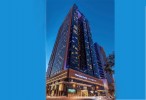Arrivals to Oman to increase at a CAGR of 5%, fuelled by visitors from India who accounted for 21% of total arrivals in 2018
Giga-projects is one of six different streams created by Saudi's Public Investment Fund (PIF) around which it has structured its investment plan
Providing value across hotel market segments through Expedia's Lodging Partner Services
 Search our database of more than 2,700 industry companies
Search our database of more than 2,700 industry companies

The Remede Spa will offer private healing sessions and a group healing class hosted by Guru Made Sumantra
Read more
Sheraton Grand Hotel, Dubai will go dark for one hour on March 30, as part of the Earth Hour 2019 initiative
Read more
Located next to five-star hotels, the development includes seven key districts spanning more than 2.4km of waterfront walkways
Read more
Marriott Internationals’ Aloft Kuala Lumpur Sentral has employed Rubel Miah as its general manager.
Read more
A high rise hotel close to Makkah in Saudi Arabia caught fire, officials from the Kingdom’s fire services have announced.
Read more
To raise awareness about disposable plastic pollution, Abu Dhabi’s Jumeirah at Saadiyat Island Resort will be hosting a swimming competition — Swim for clean seas.
Read more
2 Mar 2011
I completely and justifiably agree with these findings and I am delighted that someone took notice of this small but very significant issue. Some of the restaurants/establishments within the UAE are continually charging consumers/customers with more than the world wide price standard. That is why some of the expat and a few UAE nationals pref. to cook and eat at home and sometimes if they have an event they tend to sort and do all the cooking themselves at home or any preferred catering group rather than paying a lot of money with lesser food choices and sometimes poor service from these establishments or UAE-local entrepreneurs. Dubai had grown from a small city to a massively progressed emirate; this is because of the continuous flow of tourism and a tax free environment. So why should we charge 46% more than the average actual cost? The F&B community and the concerned government agencies should reconsider and scrutinize this issue and implement a more reasonable cost-friendly establishment with maximum supervision and precise implementation.
2 Mar 2011
Message to the Journalist: 1) Most visited restaurants are IN HOTELS which do have a 10% Municipality fee which applies. 2) Also, lets not forget that alcohol is probably more expensive in Dubai than any other place around the world. Reason is Alcohol has an import premium tax/fee of approx 120%. 3) With regards to rents, keep in mind hotels do have high cost of rent, ownership, or maintenance as it is not like simply renting a space in any building. 4) Electricity & Water charges in Dubai are also quite high. With the doubling of charges in 2007 based on the new slab system, this also adds onto the operation expense. Lets not forget that in the UAE there is a heavy use of electricity on airconditioning. 5) Restaurants in non-hotel locations, usually charge lower rates due to the fact that there is no Municipaliyt Fee, rent is cheaper, and electricity is cheaper. The downside of non-hotel locations is that revenue will likely be less since no alcohol is served. There are exceptions such as Restaurants in DIFC who do very well at lunch as non-hotel venues.
2 Mar 2011
Sorry, but Mr. Breg is clueless. Why do so many companies give restaurant employees a housing "allowance" instead of actual housing like they did 10 years ago? Because costs have gone up. Costs of visas, housing, airline tickets, quality managers, employee salaries, food costs (almost all food in the UAE is imported from somewhere in the world which adds to the costs) and the big one is rent. Only the big groups like Al Shaya and Americana get the deals on rent. Smaller companies pay more. I have worked in the U.S. and in the UAE and can tell you there is a BIG difference in the rent, the length of the leases, the overall assistance a landlord will provide in the States, and more. Mr. Breg must like the sound of his own voice because what he is saying is just incorrect....
2 Mar 2011
It is so true restaurants here in the UAE charge so much more than there counter parts in the US or Europe with the average income here is much lower than the west, the only people that can afford to eat out are the western educated EXpat with the high income or Locals. You can have a good lunch or dinner Buffet in the US for less than $15 with sea food included, but in no way you can get close to that here. Even with labor cost is much lower here & no sales Tax. No way to figure the real reason except greed & lack of real competition.
3 Mar 2011
Dear Sir, Can we not share some of these casual diners. Love to know who ther are. I am working in the hotel buisiness and i can say with 100% certainty that you can not eat in 5 start hotels for what you pay here compaired to Europe. Take the excetions out like Jumeirah , One and Only etc.
3 Mar 2011
15 to 20 dollars per meal would make a meal of 4 cost USD 60 to 80. Since the average family bill is already lower than the USD 40 - 55 for the family meal mentioned. I am confused. Can some one please explain what the deal is ? http://atrc.net.pk/products/cyber_coffee/
5 Mar 2011
Thanks to all for their feedback Dear Khawar, The AED 150-200 is what's being paid per person in branded casual dining. Dear Joe, 'Clueless'! bit strong. Let's talk net margins. Do you think branded casual dining has a higher or lower net margin here than the US or Europe? Re rents; bad news, a number of real estate companies have benchmarked rental rates and confirm that net rates per sq ft are lower here than the West. Naturally, the big guys pay less but I'm sure they accounted for this. Note that this article has taken one finding from a larger report on casual dining; the number of units in the UAE have grown by 20 times since 2004. Whilst I accept that not all units are going to be profitable, a growth of 20x is probably an indicator of health in the sector. There's more info on the report on http://www.gulfood.com/page.cfm/link=55 and http://www.hoteliermiddleeast.com/10683-uae-casual-dining-segment-worth-aed-22-billion/ More than happy to continue the debate directly on stefan@tribecreators.com and I'd be happy to share some of the supporting data too. Bit more clued? Regards
5 Mar 2011
lets get real here. I have lived in US, Europe and here. If I take my family out for a meal at a brand name that i recognise from other countries, we are paying more per head so if the rents the same and the wages are def lower, no vat and same food cost its pretty obvious whats going on here.
7 Mar 2011
I'd like to know where this survey did its benchmarking to get these figures. On face value they seem overinflated! Have the researchers tried eating out in London for AED150? If you were to include alcohol then I would agree that eating out in the GCC Country's that allow the sale of alcohol, then yes it can be more expensive. There are many surveys available on the internet to cross reference these findings. Interestingly all the ones I looked at didn?t have one GCC City mentioned in the top ten. The 'findings' of the survey mentioned in the article are disparaging and it is interesting Mr Breg mentions about a 'gap in the market'; maybe this is the reasoning behind the article and said survey. Maybe Mr Breg and his Company have created this survey in order to offer a solution to a 'problem'. Quite frankly it is very easy to create such 'statistics' and 'problems' and then offer a solution. Bravo Mr Breg, I think yourself promoting is doing a sterling job!
7 Mar 2011
Dear Simon, thanks for your feedback. The Report is solely on Casual Dining in the UAE, not GCC nor London. There are scores of key findings in the 150 page report from sector growth to ethnicity, innovation, franchising, per capita spends, supply chain, green issues, service etc. In this piece, the good folk at HotelierME chose to highlight just one page of the 150 page report. To clarify, we benchmarked actual menu items from the same casual dining brands and compared prices vs US and Europe. One of the menu items was 46% higher in the UAE; others were between 10% and 30% higher (despite sales tax elsewhere). Perhaps our next report should be a more detailed pricing benchmarking study as there seems to be a lack of information out there on this. I guess I could finish by saying 'buy the report' but I will resist the temptation as I do this solely for self promotion! Regards